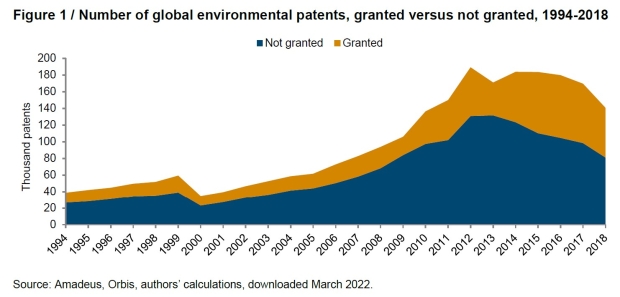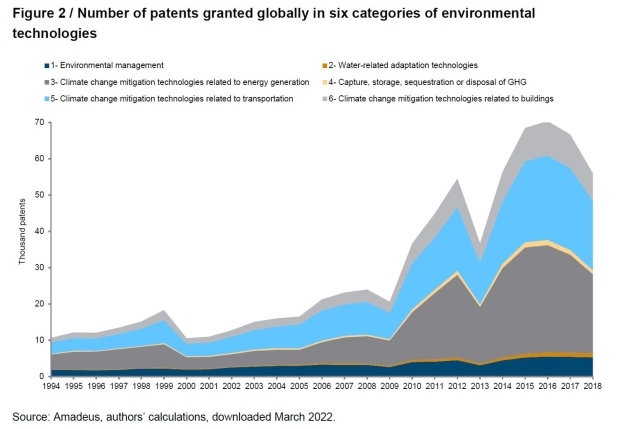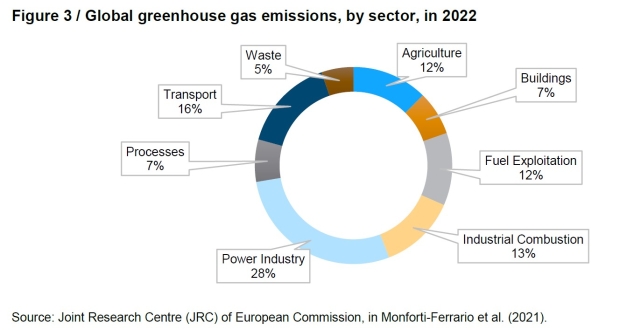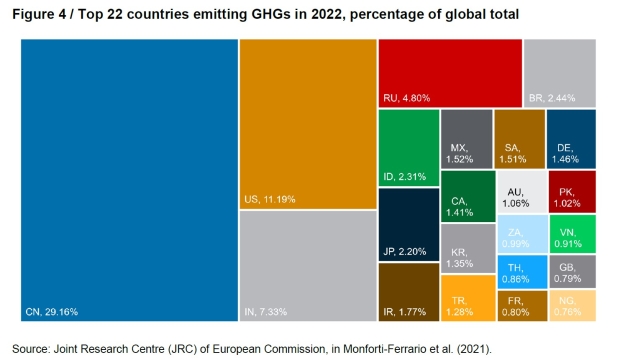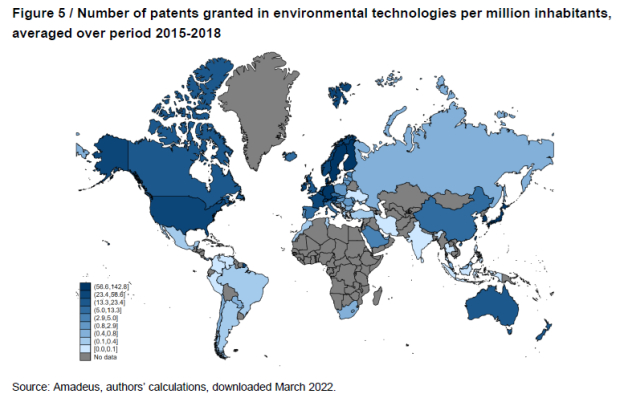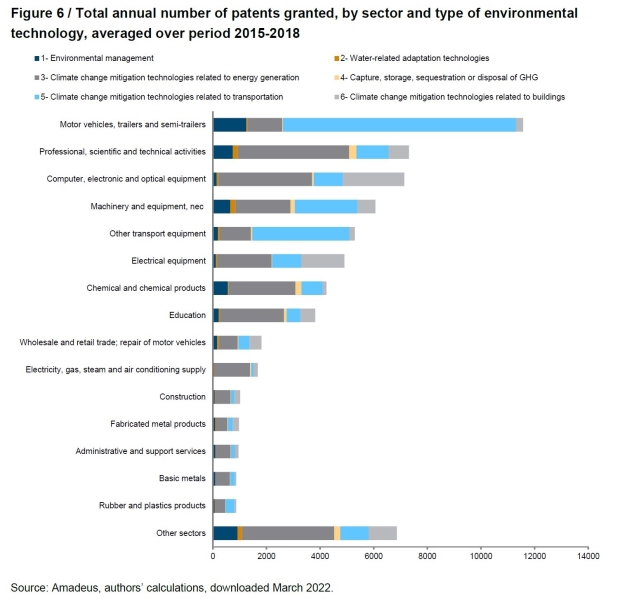Patents as green technology barometers: trends and disparities
27 November 2023
Energy and transportation lead with 36% and 34% of global green patents. Advanced economies drive innovation, leaving developing nations far behind. This gap worsens climate risks and inequalities
image credit: istock.com/Philip Steury
By Mahdi Ghodsi and Zahra Mousavi (Ferdowsi University of Mashhad, Iran)
- As the urgency of the climate crisis grows, this study offers a unique perspective on eco-innovation, through the analysis of patents granted in green and environmental technologies.
- The research identifies energy generation and transportation as the leading sectors, with 36% and 34%, respectively, of all green patents granted globally.
- However, while the advanced economies are at the forefront of green innovation, the developing nations are lagging significantly behind.
- This inequality not only exacerbates climate vulnerabilities, but also widens the global divide.
Introduction
Climate change is undeniably one of the most significant threats to humanity, and its severity is becoming increasingly evident over time. According to the Copernicus Climate Change Service (C3S),[1] July 2023 marked the hottest month on record globally, and there is the likelihood of even hotter Julys in the future. Wildfires have been raging worldwide, from California and Canada to Spain and Greece. In its latest report, the Intergovernmental Panel on Climate Change (IPCC), a United Nations body with a focus on environmental change, emphasises the urgent need to secure a liveable and sustainable future for all, noting that the window of opportunity is rapidly closing.
Thus, urgent action is required to combat climate change, and technology plays a crucial role in this. Given that technological innovations are essential to mitigate climate change, they must be carefully identified, measured and analysed, in order to pinpoint the most critical areas requiring a policy response. The analysis of environmental technologies can assist policymakers in crafting more effective policies to promote green innovations, and to foster new business opportunities and emerging markets. This article measures the stock of those technologies that could help mitigate climate change consequences, using the number of patents granted for novel green and environmental technologies, and exploring their evolution across different categories, sectors and countries over recent decades.
How do we measure innovation in environmental technologies?
Innovation typically begins with an initial idea, which is then developed through capital investment. A successful innovation often culminates in a new product or a novel production procedure. To safeguard the intellectual property of such an innovative process from plagiarism or theft, inventors register their innovation with a patent office. Consequently, patents are considered to be the ultimate outcome of an innovative process. If the patent application is deemed novel and innovative – meaning that the same innovation has not been patented previously – the office grants the patent, and its intellectual property is then protected across international jurisdictions. Businesses can then utilise the patent granted to produce the novel product or to implement the innovative production procedure. As a result, obtaining patents and securing patent grants can significantly increase a firm’s market share, turnover and valuation (Kline et al., 2019; Farre‐Mensa et al., 2020; Exadaktylos et al., 2021).
Thus, one can use the number of patents granted as a very rigorous and robust way of measuring innovation. However, as with any other research, patents should identify the technological category in which they are innovating. There are more than 240,000 technology classes defined in the Cooperative Patent Classification (CPC), which is managed by the European Patent Office (EPO) and the US Patent and Trademark Office. This classification system is an extension of the International Patent Classification (IPC) managed by the World Intellectual Property Organization (WIPO). Basing their work on CPC, Haščič and Migotto (2015) identify six major categories of technologies that can mitigate climate change and environmental degradation. These are: 1- Environmental management; 2- Water-related adaptation technologies; 3- Climate change mitigation technologies related to energy generation; 4- Capture, storage, sequestration or disposal of greenhouse gases (GHG); 5- Climate change mitigation technologies related to transportation; 6- Climate change mitigation technologies related to buildings.
Using patent and company-level data collected from Amadeus, which is provided by Bureau van Dijk (BvD), we have compiled a dataset on environmental patents owned by businesses in the global economy. Then, using the sector of activity of firms reported in the Orbis data (again provided by BvD), we identify environmental innovations across sectors and countries. The date of publication of the patent is used to identify the year of patenting. However, regardless of whether or not it is granted, a patent application is published at most 18 months after the ‘priority date’ (that is, the first time the application is filed with a patent office). It then takes an average of 10 months (though sometimes up to six years) after the publication date to provide a decision on whether or not the patent is to be granted (Farre‐Mensa et al., 2020).
Evolution of environmental technologies over the years
Figure 1 presents the development of environmental patents in the period 1994-2018. Over this period, around 32% of all published patents applications citing environmental technologies were granted. The proportion of patents granted rose to 42% in the final years under consideration. The slight reduction in the total number of patents since 2015 could be a result of problems in data collection encountered by Amadeus, which ceased to provide data after 2020. Thus, more recent years do not report patents comprehensively.
Figure 1 - Number of global environmental patents, granted versus not granted, 1994-2018
Source: Amadeus, Orbis, authors’ calculations, downloaded March 2022.
Figure 2 shows the number of patents granted globally across the six categories of environmental technologies over the period 1994-2018. Even a cursory glance makes it plain that the two categories of ‘climate change mitigation technologies related to energy generation’ and ‘climate change mitigation technologies related to transportation’ accounted for by far the greatest number of environmental patents in each year: their average share in the total number of environmental patents granted over the whole period was 36% and 34%, respectively. These general figures show that those two technologies are the most prominent green technologies adopted by global firms. This is because many advanced economies have introduced policies to develop these technologies, which are crucial in reducing the consumption of fossil fuels and cutting the consequent emissions.
Figure 2 - Number of patents granted globally in six categories of environmental technologies
Source: Amadeus, authors’ calculations, downloaded March 2022.
The fact that energy and transportation lead the way in the number of green patents granted squares with the pivotal role of these two sectors in global GHG emissions (Figure 3). Energy and transportation stand out as the two primary sources of global warming over the past couple of centuries. According to Monforti-Ferrario et al. (2021), energy production emitted a staggering 14.77bn tonnes of greenhouse gases in 2022, accounting for approximately 28% of the total. The transportation industry, which produced 8.10bn tonnes of emissions (or roughly 16% of the global total) ranks as the second-largest emitting sector.
Figure 3 - Global greenhouse gas emissions by sector in 2022
Source: Joint Research Centre (JRC) of European Commission, in Monforti-Ferrario et al. (2021).
By contrast, water-related adaptation technologies have seen limited development over the years compared to other technologies, despite its notable growth since 1994. One could argue that, since the advanced economies are primarily situated in regions with abundant water resources, adequate financial resources and policies may not have been devoted to the development of these critical technologies. Such innovations are particularly vital for less-developed economies in Africa and emerging economies in the Middle East.
In many cases, developed nations tend to prioritise their domestic challenges, with the focus primarily on reducing emissions – as is evident from their technological development efforts. While 23 wealthy economies account for half of the total accumulated carbon emissions from 1750 to 2020, in recent decades those economies have made great strides in becoming greener and emitting fewer greenhouse gases.[2] As is shown in Figure 4, by 2022 the top ranking for global GHG emissions had shifted to such emerging economies as China, India, Russia, Brazil and Indonesia. Given the limited access to the knowledge and resources necessary for technology development in developing and emerging countries, these unique challenges may persist, exacerbating the climate change vulnerability gap between the developed and the developing world.
Figure 4 - Top 22 countries emitting GHGs in 2022, percentage of global total
Source: Joint Research Centre (JRC) of European Commission, in Monforti-Ferrario et al. (2021).
Which countries patent more?
Advanced economies clearly dominate innovation in environmental technologies (Figure 5). Denmark is the top innovator in green technologies, with 142.79 patents granted per million inhabitants, followed by South Korea with 138.42, Japan with 135.34, Switzerland with 124.26 and Germany with 84.48 per million inhabitants – all countries at the forefront of environmental technology development. Notably, even non-advanced economies such as China and Saudi Arabia are making significant strides in these technologies.
One major factor contributing to greater innovation in the Northern European and Scandinavian countries may be the imminent threat of climate change – particularly rising sea levels, which could endanger these regions. Since 1880, global sea levels have risen by 21-24 cm due to global warming (Church and White, 2011). However, this is not the sole reason: the most critical factor is the implementation of policies in those countries that support innovation and the development of new technologies and increased R&D expenditure. In the latest Climate Change Performance Index, released in 2023, Burck et al. (2022) rank Denmark, Morocco and the Netherlands as the top three countries in implementing climate policies. The other Northern European and Scandinavian countries all receive a medium rating for their performance.
Figure 5 - Number of patents granted in environmental technologies per million inhabitants, averaged over period 2015-2018
Source: Amadeus, authors’ calculations, downloaded March 2022.
Which sectors are particularly innovative?
Figure 6 presents the average annual number of patents in environmental technologies across the globe, categorised by sector and averaged over the period 2015-2018. In general, high-tech manufacturing sectors and knowledge-intensive service sectors stand out as the most innovative segments of the global economy, particularly the manufacture of automobiles. It is hardly surprising that 75% of the patents in this sector should relate to transportation; this squares with the fact that transportation has historically been the second-most polluting sector (as discussed above). According to the US Environmental Protection Agency,[3] 58% of GHG emissions in the transportation sector are produced by light-duty vehicles, 23% by medium- and heavy-duty trucks, 8% by aircraft and only 2% by rail transport. The emergence of novel technologies in the sector of motor vehicles over the past three decades has mostly been visible in manufacturers of light-duty electric vehicles or trucks, and has been aimed at significantly reducing emissions.
Figure 6 - Total annual number of patents granted, by sector and type of environmental technology, averaged over period 2015-2018
Source: Amadeus, authors’ calculations, downloaded March 2022
The second-most innovative sector is the services sector, encompassing professional, scientific and technical activities. Approximately 57% of patents in this sector concern climate change mitigation technologies related to energy generation, while around 16% are related to transportation.
The third-most innovative sector is the manufacture of computers, electronic and optical equipment. Roughly 49% of green patents in this digital manufacturing sector – which is the driving force behind the modern global economy – are focused on energy generation. Additionally, approximately 32% of patents in this sector are related to buildings, which could include consumer electronic devices and appliances used within buildings, such as air conditioners.
The fourth-most innovative sector is the production of machinery and equipment, where 38.5% of the patents granted related to transportation and 33.9% to energy generation. In addition, 11.1% related to buildings and 10.6% to environmental management.
The fifth-most innovative global sector is the production of other transport equipment: 68.5% of the patents granted in that sector related to transportation and 21.9% to energy generation. In particular, the growth of air transport and the expansion of global aviation (included under ‘other transport equipment’), which has facilitated commercial passenger transportation, is thought to account for 1.9% of all GHG emissions and 2.8% of global CO2 emissions.[1] According to Lee et al. (2020), from 1940 to 2018 global aviation released a total of 32.6bn tonnes of CO2, with approximately half of this occurring within the past two decades. As of 2018, carbon dioxide emissions from aviation accounted for approximately 2.4% of overall human-generated CO2 emissions, including land-use changes. However, other fuels – such as helium or hydrogen – have failed to make major inroads as aviation fuel. Any technology that is capable of replacing the fuels currently available with renewable energy could significantly reduce emissions in the transportation sector.
Policy recommendations
In recent decades, many businesses within the global economy have succeeded in developing innovative green technologies, resulting in the granting of numerous patents. The ownership of these vital technologies is concentrated primarily in the developed world. The advanced economies of the northern hemisphere possess the financial wherewithal to implement policies that support the advance of green technologies, while also allowing inventors to safeguard their intellectual property rights to these globally significant innovations. By contrast, the global South and the least-developed nations find themselves most vulnerable, lacking access to such advances and struggling with severe drought conditions and other immediate consequences of global warming. These ongoing vulnerabilities serve as driving factors for both internal and external migration, potentially leading to increased waves of climate-induced migration towards the environmentally advanced Northern countries. The least-advanced economies lack the financial and human capital resources required to develop and adopt the crucial technologies for mitigating climate change.
Meanwhile, climate change has exacerbated economic inequality across countries. Diffenbaugh and Burke (2019) showed that the economic inequality between the wealthiest and the poorest nations has increased by 25% more than it would have done without global warming. Therefore, the wealthy nations, which account for most of the GHG emissions so far, have an ethical responsibility to tackle the crisis they have contributed to. According to the United Nations Intergovernmental Panel on Climate Change (IPCC, 2023), by the end of this decade the developing countries may require up to USD 300bn annually for adaptation measures.
A recent study by Ghodsi and Jovanovic (2022) underscores the significance of foreign direct investment (FDI) as a powerful tool for transferring green technologies from various parts of the world to advanced economies like Austria. Consequently, it is imperative that international organisations (including the United Nations) take the lead – with the support of advanced economies – in shaping global policies aimed at attracting environmentally friendly FDI to poor countries and at developing green technologies that are accessible to the least-developed countries. Such policies have the potential not only to facilitate the transfer of knowledge, expertise and technology from the resource-rich Northern countries, but also to create employment opportunities and promote development in the global South and the least-developed nations.
The spectrum of green technologies is vast and diverse, and offers multifaceted benefits to global society. For instance, one such policy initiative could empower economically robust advanced economies to develop cutting-edge technologies, patented by firms, to desalinate seawater and purify waste water. Such innovations could significantly enhance living conditions and agricultural output in vulnerable regions across the world.
Footnotes:
[1] https://climate.copernicus.eu/july-2023-warmest-month-earths-recent-history
[2] https://www.nrdc.org/stories/rich-polluting-nations-still-owe-developing-world
[3] https://www.epa.gov/greenvehicles/fast-facts-transportation-greenhouse-gas-emissions
[4] https://ourworldindata.org/co2-emissions-from-aviation#:~:text=In%20this%20article%20we%20take,2.5%25%20of%20CO2%20emissions
References:
Burck, J., Uhlich, T., Bals, C., Höhne, N., Nascimento, L., Tavares, M. and Strietzel, E. (2022). Climate Change Performance Index 2023: Monitoring climate mitigation efforts of 59 countries plus the EU – covering 92% of the Global Greenhouse Gas Emissions. Climate Action Network International.
Church, J.A. and White, N.J. (2011). Sea-level rise from the late 19th to the early 21st century. Surveys in Geophysics, 32, 585-602.
Diffenbaugh, N.S. and Burke, M. (2019). Global warming has increased global economic inequality. Proceedings of the National Academy of Sciences, 116(20), 9808-9813.
Exadaktylos, D., Ghodsi, M. and Rungi, A. (2021). What do firms gain from patenting? The case of the global ICT industry. https://dx.doi.org/10.2139/ssrn.3897611
Farre‐Mensa, J., Hegde, D. and Ljungqvist, A. (2020). What is a patent worth? Evidence from the US patent ‘lottery’. Journal of Finance, 75(2), 639-682.
Ghodsi, M. and Jovanovic, B. (2022). Determinants and effects of foreign direct investment in Austria: Spillovers to novel innovative environmental technologies. wiiw Working Paper No. 221. wiiw, Vienna.
Haščič, I. and Migotto, M. (2015). Measuring environmental innovation using patent data. OECD Environment Working Papers, No. 89. OECD Publishing, Paris. https://doi.org/10.1787/19970900
IPCC (2023). Summary for policymakers. In: Climate Change 2023: Synthesis Report. Contribution of Working Groups I, II and III to the Sixth Assessment Report of the Intergovernmental Panel on Climate Change. IPCC, Geneva, pp. 1-34. DOI: 10.59327/IPCC/AR6-9789291691647.001
Kline, P., Petkova, N., Williams, H. and Zidar, O. (2019). Who profits from patents? Rent-sharing at innovative firms. Quarterly Journal of Economics, 134(3), 1343-1404.
Lee, D.S., Fahey, D.W., Skowron, A., Allen, M.R., Burkhardt, U., Chen, Q., … and Wilcox, L.J. (2020). The contribution of global aviation to anthropogenic climate forcing for 2000 to 2018. Atmospheric Environment, 117834. https://doi.org/10.1016/j.atmosenv.2020.117834
Monforti-Ferrario, F., Crippa, M., Guizzardi, D., Solazzo, E., Muntean, M., Schaaf, E., ... & Vignati, E. (2021). GHG emissions of all world countries. EDGAR v6.0 Greenhouse Gas Emissions. European Commission, Joint Research Centre (JRC) [Dataset] PID. http://data.europa.eu/89h/97a67d67-c62e-4826-b873-9d972c4f670b

